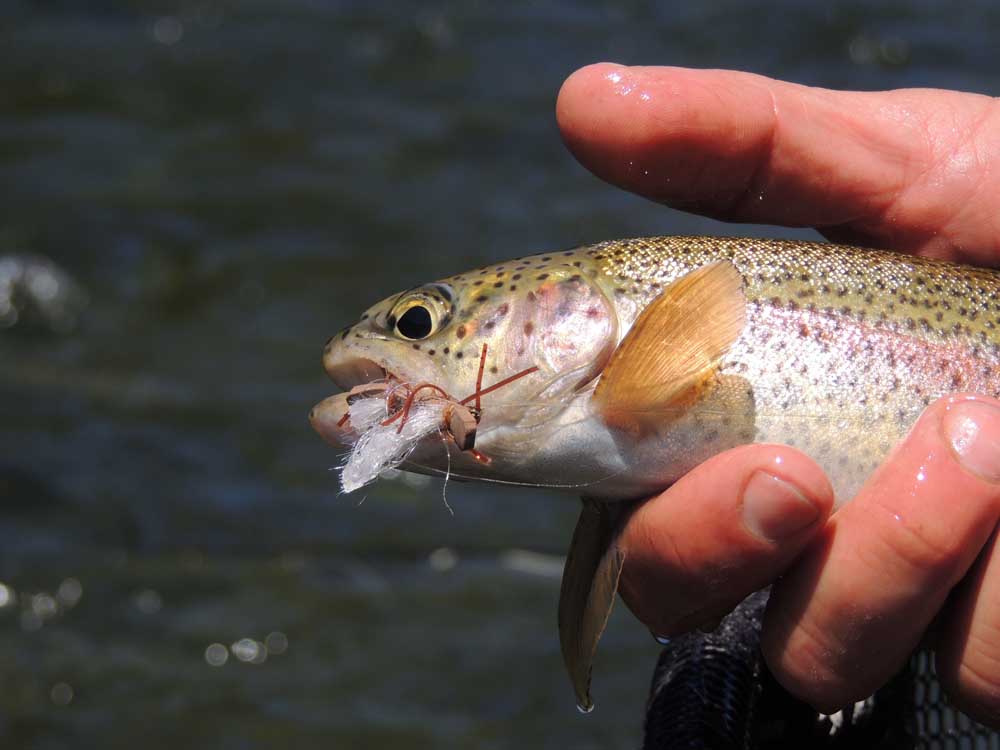Fly-fishing the McKenzie River
Published 12:00 am Wednesday, July 2, 2014

- Gary Lewis / For The BulletinThis trout fell for a Chubby Chernobyl, a high-riding dry that represents a golden stonefly.
Clear water, shaded by alders, fast over smooth stones. Drifting the McKenzie in June is an exercise in belief.
My golden stonefly imitation drifted down with the current a little faster than the boat. I imagined there were trout and they looked up.
Trending
My first encounter with trout and a dry fly was at this level. It was a Sunday afternoon. I was 12, the fish was as old as time, the insect was a white Miller moth that touched down on the water. I whispered a prayer. “Lord, if you want me to be a fly-fisherman, send a trout to eat that moth.”
With the sun on his wings, the moth bounced over the water, touched down, lifted, touched again. A trout broke the stillness of the pool, nosed through the surface and ate the moth. Church was over.
In those days, to become a fly-fisherman meant becoming a different person. Fly-fishermen wore tweed, they wore funny hats, they were contemplative, they smoked pipes. This was what I must become. It was big stuff for a 12-year-old. I wasn’t even sure my mom would let me smoke a pipe.
On Monday, my grandpa drove me to the store. I bought a 7-weight fly rod with the money I’d saved from mowing lawns. I knew I’d start by fishing nymphs and wet flies, but as soon as I could, I’d try to catch a trout on a dry.
Dry-fly fishing is about belief. We know that 99 percent of what fish eat, they eat beneath the surface. We know that most of the time this is the way to catch a trout. But we imagine a trout is there, that he is hungry, that he looks up.
It all came back in June on the McKenzie with my dad in the boat and guide Steve Erickson on the oars. In the other boat, with guide Mel Crabb, were our friends Mike and Dianne Green. We’d met for dinner at Brasada Ranch the evening before, warmed up in the morning at Sisters Coffee then convened at The Fly Fisher’s Place on Main Street in Sisters. Ninety minutes later we were sliding our boats into the McKenzie.
Trending
We swung wet flies at first, but above the water there were golden stones, midges, caddis and mayflies. Erickson pointed out the occasional green drake, buzzing like a helicopter at canopy level over the river.
I tied on a golden stone imitation, and, as we drifted, I cast to riffles, along seams and into the shade. In one long run, I saw a trout elevate and take the fly. It was a wild rainbow about 10 inches long, and it was a long time before I saw another. The next fish that sipped my fly was bigger. Suddenly it was there beneath the fly, drifting down with it. Then it committed, ate it and went airborne. A moment later it threw the hook.
For the most part, our 9-mile drift was in an easy stretch of river, but there are some legit class III rapids. One piece of big water gave me a lapful of white and foamy McKenzie. There are a lot of options for put-ins and take-outs along the river, so it is possible to make shorter runs and avoid the trickier whitewater.
Erickson was an expert on the oars, so good that afterward I suspected my drenching might have been intentional. I probably deserved it.
Our half-day run gave us a look at a lot of good water. Some sections of the river have good populations of wild trout, Erickson said, while others are more likely to produce planted hatchery trout. When the sun began to go behind the trees, we drifted through patches of shade and out into golden afternoon light.
Erickson said the action really begins to heat up in July and August as the water warms and there are more bugs on the surface and more hatchery trout as well.
A few more caddis began to show on the surface. I tied on a No. 14 Elk Hair Caddis and greased it with a little floatant.
Our luck began to change. Or maybe it wasn’t luck at all, but belief, manifested in trout that suddenly appeared where no trout had been seen. This one, brought to hand, looked to be 14 inches, wild, spotted, with a brilliant red sash. We admired it and let it go.
The next fish was a hatchery trout and they came quickly after that. Dad switched to an Elk Hair Caddis. Downstream, Crabb and crew had cracked the code as well, with a McKenzie Caddis pattern.
When the bite slowed, I raised the rod tip and began to skitter the bug at the end of each drift. Then trout after trout leaped clear of the water to take the fly. If we’d been keeping fish, we would have caught double our limits, but we released them for you to catch. If you believe.
—Gary Lewis is the host of “Frontier Unlimited” and author of “John Nosler – Going Ballistic,” “A Bear Hunter’s Guide to the Universe,” “Hunting Oregon” and other titles. Contact Lewis at www.GaryLewisOutdoors.com.







